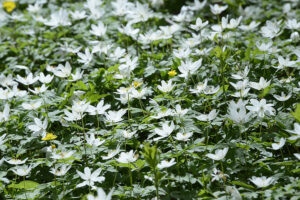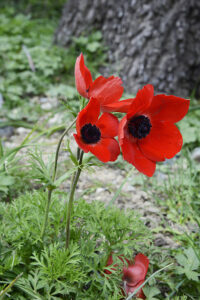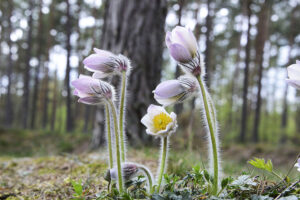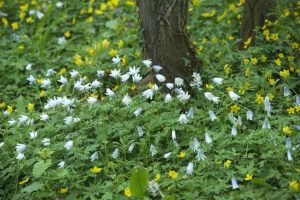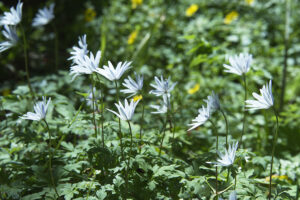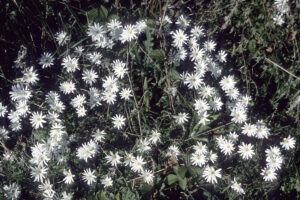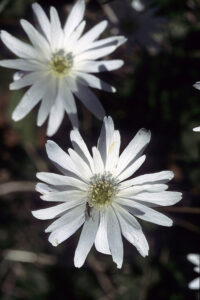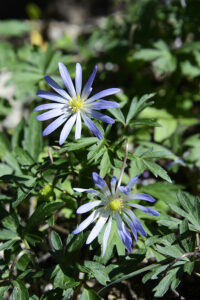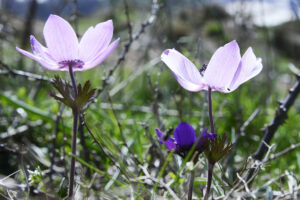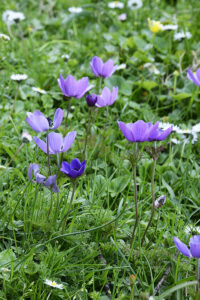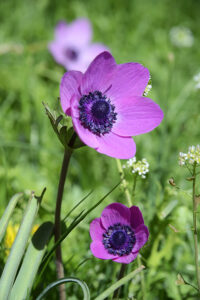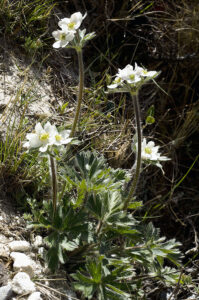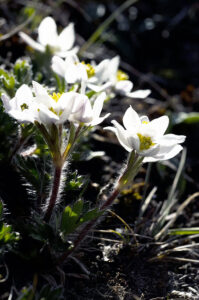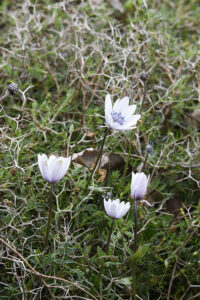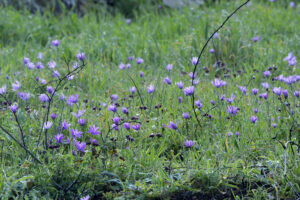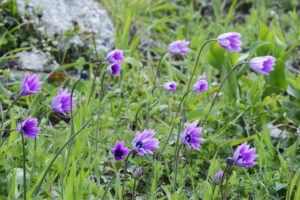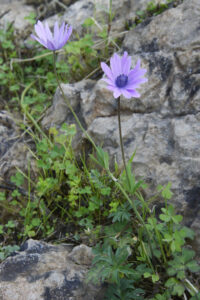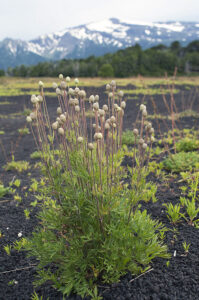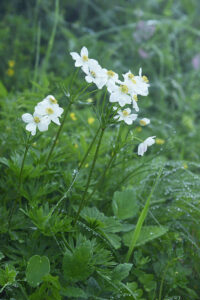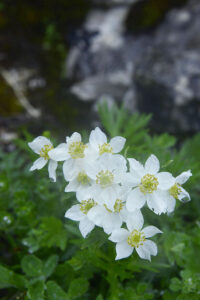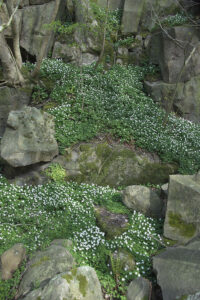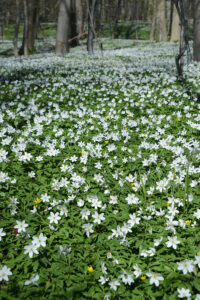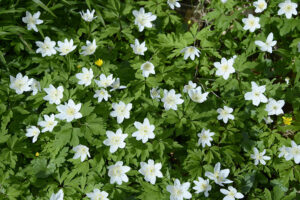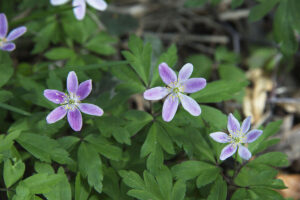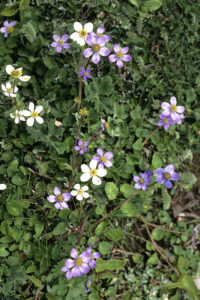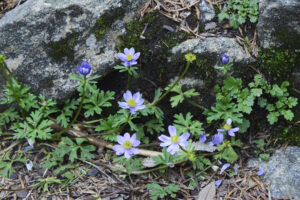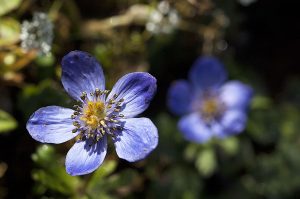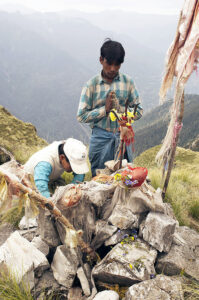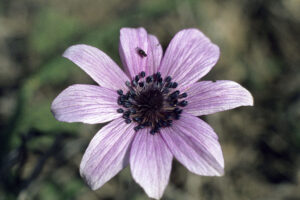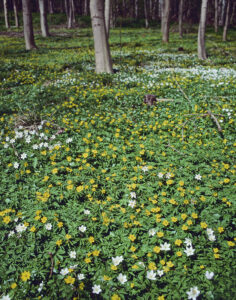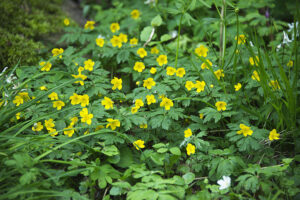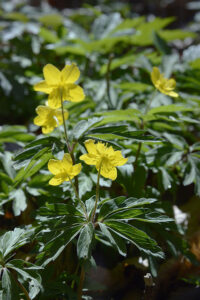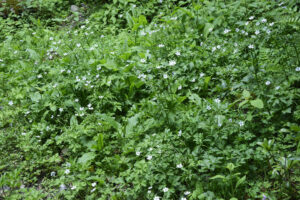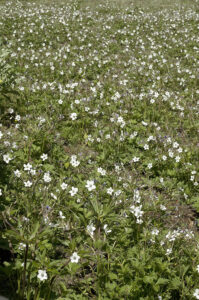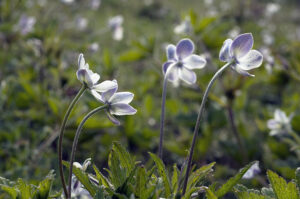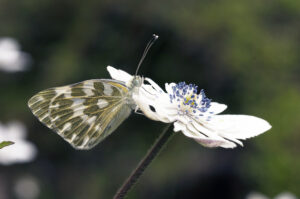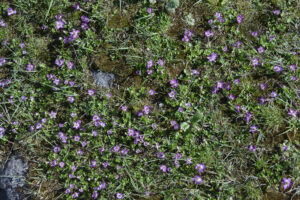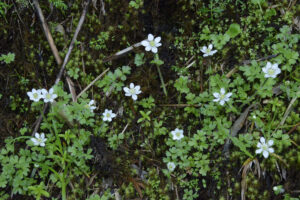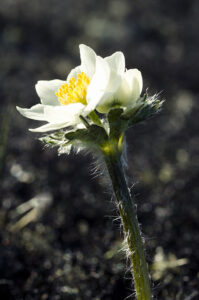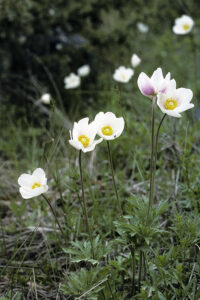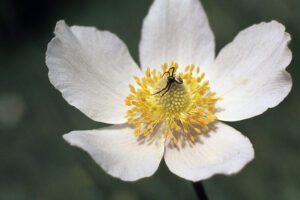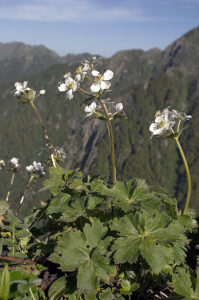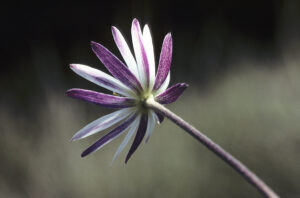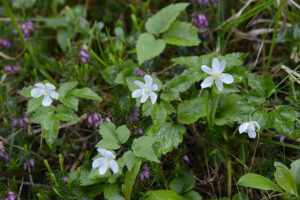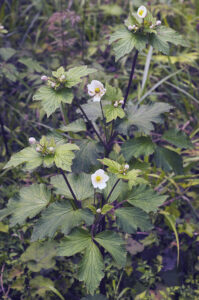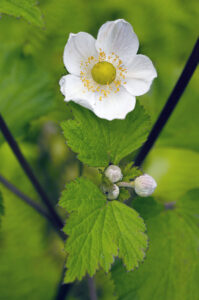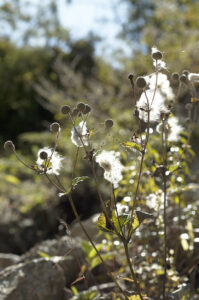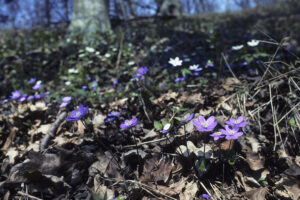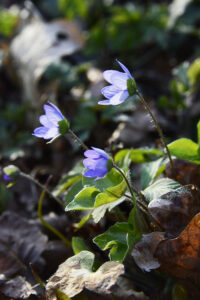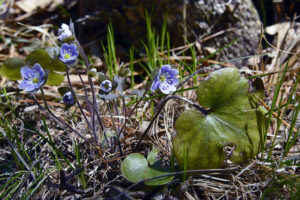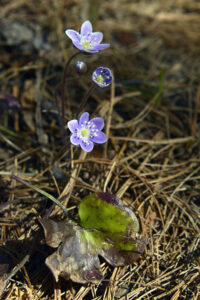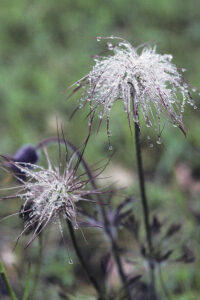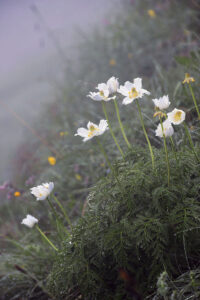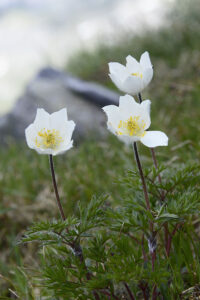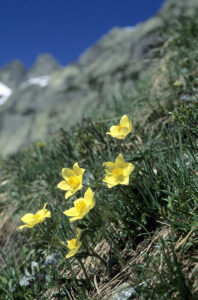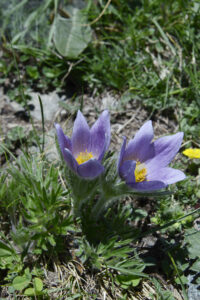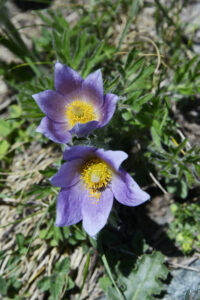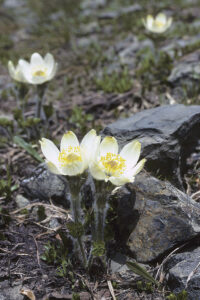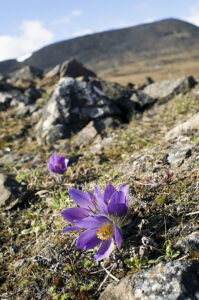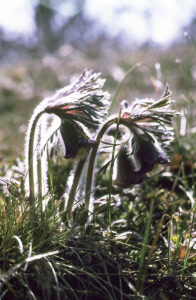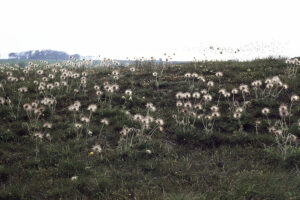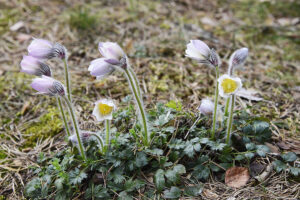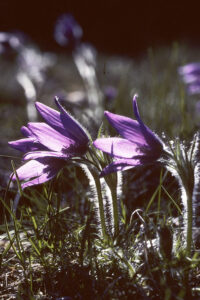Anemones and pasque flowers
Carpet of wood anemones (Anemone nemorosa), eastern Jutland, Denmark. Yellow anemone (A. ranunculoides) and dog’s mercury (Mercurialis perennis) are also seen. (Photo copyright © by Kaj Halberg)
Crown anemone (Anemone coronaria) of the blood-red variety, Omalos Plains, Crete. (Photo copyright © by Kaj Halberg)
Spring pasque flower (Pulsatilla vernalis), Lilla Frö, Öland, Sweden. (Photo copyright © by Kaj Halberg)
Common blue anemone, or European hepatica (Hepatica nobilis var. nobilis), eastern Jutland, Denmark. The flowers usually occur before the leaves, but sometimes they evolve simultaneously. A leaf from the previous year is seen in the lower right corner. (Photo copyright © by Kaj Halberg)
Anemones are a large group of plants in the buttercup family (Ranunculaceae), which, in its widest sense, contains 6 genera. Some authorities, however, lump all of them in the genus Anemone.
These plants do not possess sepals – or maybe the sepals are coloured, and the petals are missing. On this page, I use the term petals. The fruit is a cluster of tiny nut-like seeds, called achenes. In many species, they are embedded in dense woolly hairs.
Roman naturalist Pliny the Elder (23-79 A.D.) says that you should pick the first anemone plant you see in spring, wrap it in a red cloth and keep it here, until you encounter a person with ‘the 3rd and 4th day fever’ (malaria). Then you put the plant on the sick person, who will surely be healed by this esteemed herb.
Pliny linked the name anemone to the Ancient Greek word anemos (’wind’), and windflower is a common English name of these plants. The connection, however, is very hard to see, and, as indicated below, it is probably a wrong assumption.
According to Philip K. Hitti, in his book History of Syria including Lebanon and Palestine (1951), the Arabic name of the crown anemone (Anemone coronaria) is shaqa’iq an-Nu’man, which literally translates as ‘the wounds, or pieces, of Nu’man’. Nu’man probably refers to the Sumerian god of food and vegetation, Tammuz, whose Phoenician name was Nea’man. It is generally believed that the Arabic an-Nu’man became anemos in the Greek, and that Tammuz was adopted by the Greeks as Adonis, who died of his wounds while hunting wild boar, and was transformed into a blood-red flower, stained by his blood. In the Near East, the crown anemone is often of the blood-red variety (see picture at the top of this page).
Anemone True anemones
This group, counting about 150 species, is widespread, found on all continents except Antarctica, with the largest diversity in northern temperate regions.
Lately, taxonomists at the Kew Gardens in London have transferred many species of this genus to the genera Eriocapitella, Anemonoides, and Anemonastrum. This is based on minor differences, and here I have chosen to retain the former systematics.
Anemone apennina Apennine anemone
As its name implies, this plant grows in the Apennine Mountains of Italy, and it is also distributed in the southern Alps and on the Balkan Peninsula, southwards to northern Greece. It is widely naturalized elsewhere in Europe. The flower colour varies between white and rather dark blue.
A pale-blue, or sometimes pure white form, var. pallida, is found in woods in the eastern half of the Danish island Bornholm. Its presence here is a bit of a mystery, since the nearest occurrence of the species is in Switzerland.
Some botanist believe that it was introduced. One authority (Hansen 2012) says: ”In 1532, Peder Oxe [a Danish nobleman] was sent on a cultural education tour through Europe, together with botanist Kristiern Torkelsen Morsing. This trip lasted five years, and Italy was included in the itinerary. (…) In 1553, Peder Oxe bought 30 farms on Bornholm (…), and as he was a keen gardener, it is quite possible that he brought this plant to the island.”
Pale-blue form of Apennine anemone, Bornholm, Denmark. Yellow anemone (A. ranunculoides) is seen in the background. (Photos copyright © by Kaj Halberg)
White form of Apennine anemone, Bornholm. (Photos copyright © by Kaj Halberg)
Anemone blanda Balkan anemone
This species, by some authorities named Anemonoides blanda, is distributed in the Balkans, Turkey, the Caucasus, Lebanon, and Syria, growing in shrubberies and on stony slopes, up to elevations around 2,600 m.
It grows to about 25 cm tall, basal leaves tripartite, segments deeply lobed with rounded or sharp teeth along the margin, green above, usually purplish beneath. Involucral leaves are stalked, tripartite, segments similar to those of the basal leaves. Flowers solitary, with 12-15 narrowly oblong sepals/petals, dark blue, pale blue, reddish-purple, or white, to 2.5 cm long.
The specific name is Latin, meaning ‘pleasant’.
Balkan anemone, form with pale blue flowers, Emli Valley, Ala Dağları, Turkey. (Photo copyright © by Kaj Halberg)
Anemone coronaria Crown anemone
This gorgeous plant, also known as poppy anemone, comes in a wide variety of colours: red, purple, blue, or white. It is most common in the eastern Mediterranean, especially in Lebanon, Syria, Jordan, and Israel. It is also found from southern Turkey westwards through the Balkans and Italy to southern France and north-western Africa, and eastwards to the Caucasus and western Iran.
The specific name means ‘crowned’ or ‘garlanded’, of course referring to the ‘regal’ flowers. In Hebrew, its name is kalanit, derived from kala, meaning ‘bride’. The name poppy anemone refers to the resemblance of the red form to poppies. The plant very much resembles Ranunculus asiaticus, which also comes in various flower colours, but has both petals and sepals.
Various colour morphs of crown anemone, Omalos Plain, Crete. (Photos copyright © by Kaj Halberg)
Anemone demissa
This Asian plant is also known as Anemonastrum demissum. The flowers, which may be white, blue, purple, or red, are clustered in a dense umbel at the end of the stalk. It is found from western Nepal eastwards to south-western China, growing on open slopes at high altitudes, between 3,300 and 4,500 m.
White-flowered form of Anemone demissa, Khumbu, eastern Nepal. (Photos copyright © by Kaj Halberg)
Anemone heldreichii
This species is endemic to the Greek islands of Crete and Karpathos. The specific name was given in honour of German botanist Theodor von Heldreich (1822-1902), who lived in Athens from 1851. From here, he undertook numerous excursions throughout Greece and in Turkey. He described 7 new genera and more than 700 species new to science.
Anemone heldreichii, between Omalos and Prines, Crete. In this picture, it makes its way up through a densely spiny species of spurge, Euphorbia acanthothamnos. (Photo copyright © by Kaj Halberg)
Anemone hortensis Broad-leaved anemone
This species, which may reach a height of 40 cm, is found along the Mediterranean, from south-eastern France across Italy and the Balkans to Turkey. The specific name is derived from the Latin hortus (‘growing in vegetable gardens’), alluding to this plant being easily cultivated.
Broad-leaved anemone is very common in Sicily, here photographed near Vizzini (upper two), and in Riserva Naturale dello Zingaro. (Photos copyright © by Kaj Halberg)
Anemone multifida
South America is home to 11 species of anemone, found mainly in the Andes Mountains. This species is distributed in montane areas of Chile and Argentina. According to some authorities, i also occurs in the major part of North America. To me, it seems rather odd that plants so far apart should be the same species.
Anemone multifida, Parque Nacional Huerquehue, Chile. (Photo copyright © by Kaj Halberg)
Fruiting Anemone multifida, Parque Nacional Conguillio, Chile. (Photo copyright © by Kaj Halberg)
Anemone narcissiflora Narcissus-flowered anemone
This plant, also known as Anemonastrum narcissiflorum, is found in several European mountain areas, including the Pyrenees, the Alps, and the Apennines, eastwards across the Caucasus to Central Asia and Siberia, and thence south to northern Pakistan and Korea. It also extends into north-western North America, southwards to central British Columbia, with isolated occurrence on Vancouver Island and in mountains of Wyoming and Colorado.
It grows in grasslands and open woods, and along roads, preferably on moist ground. In Central Asia and North America, it has been found up to an altitude of 4,000 m. Medicinally, this plant has been utilized by the Aleuts to stop bleeding.
The specific and popular names refer to the flowers, which somewhat resemble those of poet’s daffodil (Narcissus poeticus). The name Narcissus is often linked to the Greek myth of the youth Narkissos, who was known for his beauty. However, he admired his own reflection in a pond so much that he fell into the water and drowned. The poet’s daffodil sprouted where he died. However, according to Roman naturalist Pliny the Elder (23-79 A.D.), this plant was not named after the youth, but after its powerful fragrance, from the Greek narkao (‘I grow numb’).
Other pictures, depicting narcissus-flowered anemone, may be seen on the page Plants: Flora of the Alps and the Pyrenees.
Narcissus-flowered anemone with raindrops, Rossfeld, near Berchtesgaden, Germany. (Photos copyright © by Kaj Halberg)
Anemone nemorosa Wood anemone
In spring, carpets of delicate flowers of this plant cover the floor of countless forests in northern Europe – a true sign of spring. This is a purely European plant, found from Ireland eastwards to western Russia, and from northern Scandinavia south to Italy and the Balkans.
Formerly, in Denmark and elsewhere, super-natural forces were ascribed to this species. If, early in spring, without speaking, you would eat the first three wood anemones you saw, you would surely avoid getting ague (the old term for malaria).
It has been suggested that English author J.R.R. Tolkien (1892-1973), in his famous novel The Lord of the Rings, was inspired by the wood anemone to create simbelmynë, a white flower which grew on the grave mounds of the Kings of Rohan. I find this hard to believe, as Tolkien writes: “…they blossom in all seasons of the year,” which can hardly be said about the wood anemone.
Wood anemones, growing among rocks in the Svartinge Valley, Bornholm, Denmark. (Photo copyright © by Kaj Halberg)
Carpets of wood anemones, eastern Jutland, Denmark. (Photos copyright © by Kaj Halberg)
Occasionally, forms of wood anemone with reddish or purplish petals may be encountered, in this case near Bastemose, Bornholm, Denmark. (Photo copyright © by Kaj Halberg)
Anemone obtusiloba
A very common plant in the Himalaya, especially on grazing grounds, found at altitudes between 2,100 and 4,300 m, from Afghanistan eastwards to south-western China. It comes in three colour morphs: blue, white, and yellow, the yellow form being restricted to Kashmir. In Nepal, juice of the root is used for eye trouble. Some authorities place this species in the genus Anemonastrum.
This picture, showing the blue as well as the white form, was taken on the ridge Propang Danda, Langtang National Park, Nepal. (Photo copyright © by Kaj Halberg)
Blue form of Anemone obtusiloba, observed near Magingoth (top), and on the grazing ground Darjaling Kharka, both Langtang National Park, Nepal. (Photo copyright © by Kaj Halberg)
In the picture below, Hindus are placing a flower offering, consisting of blue and white Anemone obtusiloba, yellow Geum elatum, and yellow Primula stuartii, on a stone cairn, dedicated to a local goddess, atop the peak Rakhundi (3622 m), Great Himalayan National Park, Himachal Pradesh, India. This goddess is probably a form of Devi, the god Shiva’s shakti (female aspect), as the trident is a symbol of Shiva.
Other such offerings are described on the page Religion: Animism, whereas Primula stuartii is presented in detail on the page Plants: Primroses, and Geum elatum on the page Plants: Himalayan flora.
(Photo copyright © by Kaj Halberg)
Anemone pavonina Peacock anemone
This plant is quite similar to Anemone coronaria, but has more petals, which are narrower. It is distributed in southern Europe, from south-eastern France eastwards to Turkey.
Peacock anemone, Lake Volvi, Greece. (Photo copyright © by Kaj Halberg)
Anemone ranunculoides Yellow anemone
This plant is easily identified by its yellow flowers. It is distributed in Europe, eastwards to northern Turkey and the Caucasus. The specific name means ’Ranunculus-like’, referring to the buttercup-coloured flowers. Other popular names include yellow wood anemone and buttercup anemone.
Under favourable conditions, yellow anemone may form carpets like Anemone nemorosa (above). Occasionally, hybrids between the two species occur, called Anemone x lipsiensis. They have pale yellow flowers.
Carpet of yellow anemone, with a few wood anemones, eastern Jutland, Denmark. (Photo copyright © by Kaj Halberg)
Yellow anemone, Bornholm, Denmark. Also seen are wood anemone, the white form of bulbous corydalis (Corydalis cava), and leaves of lesser celandine (Ranunculus ficaria). (Photo copyright © by Kaj Halberg)
Yellow anemone, Møn, Denmark. (Photo copyright © by Kaj Halberg)
Anemone rivularis
This is the commonest of the c. 17 Himalayan species of the genus. It is distributed from northern Pakistan eastwards across Tibet to China, and also found in Sri Lanka and Sumatra. In the Himalaya, it grows in meadows and on grazing grounds and fallow fields, at elevations between 2,100 and 4,000 m.
In Nepal, the seeds are roasted and pickled. Medicinally, a paste of the plant is used for cough and fever, a decoction of the root is applied to wounds, and juice from the leaves is mixed with water and inhaled to relieve sinusitis. Some authorities place this species in the genus Eriocapitella.
Large growth of Anemone rivularis, Riverside, Langtang National Park, Nepal. (Photo copyright © by Kaj Halberg)
Anemone rivularis, Sanasa, Khumbu, Nepal. (Photos copyright © by Kaj Halberg)
Himalayan bath white (Pontia daplidice ssp. moorei), feeding in a flower of Anemone rivularis, Sainj Valley, Great Himalayan National Park, Himachal Pradesh, India. (Photo copyright © by Kaj Halberg)
Anemone rupestris
A tiny plant, often prostrate, stem to 7 cm long, leaves tripartite, to 2 cm long, leaf-stalk to 2 cm long, corolla white, pale lilac, pink, or red, stamens up to 8, black, stigma yellow. It is found in Central Asia, from Uttarakhand eastwards across the Himalaya to northern Myanmar and south-western China, growing on open slopes and in shrubberies at elevations between 2,500 and 5,000 m.
Some authorities place this species in the genus Anemonastrum.
Various colour morphs of Anemone rupestris, photographed between Tharepati and Phedi, Langtang National Park, central Nepal. (Photos copyright © by Kaj Halberg)
Anemone sibirica Siberian anemone
A small, hairy plant, found on steppes and in tundra in eastern Siberia, Mongolia, Alaska, and north-western Canada. Some authorities regard it as a subspecies of Anemone narcissiflora, variously called ssp. crinita or ssp. sibirica. In some papers, it is referred to as Anemonastrum sibiricum.
Siberian anemone, Zolotoi Khrebet (‘Golden Ridge’), Chukotka, eastern Siberia. (Photos copyright © by Kaj Halberg)
Anemone sylvestris Snowdrop anemone
Native to central and eastern Europe, eastwards across Siberia, and also in the Caucasus and Central Asia, this species is partial to shaded drier grasslands and deciduous woodlands on limestone soil.
Snowdrop anemone, Hanila, Estonia. (Photo copyright © by Kaj Halberg)
Close-up of snowdrop anemone, Öland, Sweden. Note the spider. (Photo copyright © by Kaj Halberg)
Anemone tetrasepala
This stately Himalayan plant, also known as Anemonastrum tetrasepalum, may grow to 75 cm tall. It is partial to rocky slopes between 2,100 and 3,600 m altitude, found from Afghanistan eastwards to Uttarakhand and south-western Tibet.
Anemone tetrasepala is very common in Great Himalayan National Park, Himachal Pradesh, where these pictures were taken. (Photos copyright © by Kaj Halberg)
Anemone thomsonii
Restricted to highlands of East Africa, including Kilimanjaro and Mount Hanang in Tanzania, and Mount Kenya and the Aberdare Mountains in Kenya, this plant was described in 1885, based on a specimen collected by Scottish geologist Joseph Thomson (1858-1895) – an excellent explorer, who never caused the killing of any native, or lost any of his men due to confrontations. His motto was “He who goes gently, goes safely; he who goes safely, goes far.”
Besides this plant, Thomson’s gazelle (Eudorcas thomsonii) and Thomson’s Falls, near Nyahururu, are named for him.
Anemone thomsonii, Aberdare National Park, Kenya. The underside of the petals is often purplish. (Photos copyright © by Kaj Halberg)
Anemone trifolia Three-leaved anemone
This species resembles Anemone nemorosa (above), but is easily identified by its leaves, which have three broadly ovate, serrated leaflets. This species is thought to be the most ancient of the group, formerly having a much wider distribution across Europe than today, where it occurs in four separate areas: northern Portugal and Spain, the eastern and southern Alps and the Apennines, the Carpathians, and finally Finland.
In Finland, it was first noticed as late as 1929, and some authorities speculate that it was intentionally brought to the country and planted by horticulturists. (Source: luontoportti.com/suomi/en/kukkakasvit/three-leaved-anemone)
Other pictures, depicting this plant, may be seen on the page Plants: Flora of the Alps and the Pyrenees.
Three-leaved anemone in rainy weather, beneath Passo Falzarego, Dolomites, Italy. The red flowers are spring heath (Erica carnea). (Photo copyright © by Kaj Halberg)
Anemone vitifolia Grape-leaved anemone
The specific and popular names of this plant were given in allusion to the upper stem leaves, which resemble those of the grape vine (Vitis vinifera). Some authorities place this species in the genus Eriocapitella.
It is found from Afghanistan eastwards through the Himalaya and southern Tibet to China and Taiwan, growing in open forests and grasslands, and along rivers.
In the Himalaya, it is used medicinally for various ailments, including toothache, headache, and dysentery. The toxic leaves are strewn in rivers as fish poison, and powdered leaves are applied to the head to kill lice. The woolly seed hairs were formerly used as tinder.
Grape-leaved anemone, Mingtsih, Taiwan. (Photos copyright © by Kaj Halberg)
Fruiting grape-leaved anemone, Bagarchap, Annapurna, Nepal. (Photo copyright © by Kaj Halberg)
Hepatica Blue anemones
These plants are restricted to the Northern Hemisphere, occurring from Europe eastwards to central Siberia, in the Far East, and in eastern North America. They have caused much confusion among taxonomists regarding the number of species, which varies from 7 to 13, depending on authority. Some authorities place them in the genus Anemone.
The genus includes the following species, subspecies, and/or varieties:
H. nobilis var. nobilis (European hepatica, or blue anemone), distributed from Scandinavia and the Baltic southwards to Italy and the Balkans.
H. pyrenaica = H. nobilis var. pyrenaica (Pyrenean hepatica), found in the Pyrenees and northern Spain.
H. transsilvanica (Romanian hepatica), restricted to mountains in Romania.
H. falconeri, found in montane forests of Central Asia.
H. asiatica = H. nobilis var. asiatica, distributed in central and eastern China, Korea, and south-eastern Siberia.
H. henryi, found in central and western China.
H. yamatutai, restricted to Mount Emei Shan, Sichuan Province, China.
H. insularis, found in southern Korea.
H. maxima, endemic to Ulleung-do Island, Korea.
H. japonica = H. nobilis var. japonica, found in Japan.
H. pubescens = H. nobilis var. pubescens, restricted to central Honshu, Japan.
H. americana = H. nobilis var. obtusa (round-lobed hepatica), distributed in eastern North America.
H. acutiloba = H. nobilis var. acuta (sharp-lobed hepatica), likewise found in eastern North America.
Popular names of these plants include hepatica, liverleaf, or liverwort, named for their mostly three-lobed leaves, hepatica being derived from the Greek hepar (‘liver’). As the outline of the leaf resembles the human liver, followers of the Doctrine of Signatures claimed that they could be used for treatment of liver disorders. This is not the case, but the plant has been used to treat wounds, as an astringent, and as a diuretic.
A widely accepted theory is that the two American species, which have roughly the same area of distribution, evolved during the latest Ice Age, where two populations were isolated from each other by the advancing ice sheet. When the ice smelted, both populations were able to spread, but had by now become so different that they do not interbreed.
European hepatica (H. nobilis var. nobilis), eastern Jutland, Denmark. (Photos copyright © by Kaj Halberg)
Large growth of European hepatica, Knisa Mosse, Öland, Sweden. (Photo copyright © by Kaj Halberg)
Reddish form of European hepatica, Garphyttan National Park, Sweden. (Photo copyright © by Kaj Halberg)
Round-lobed hepatica (H. americana), Clement Farm Conservation Area, Massachusetts. The leaves are from the previous year. (Photos copyright © by Kaj Halberg)
Pulsatilla Pasque flowers
These plants, comprising about 45 species, are widely distributed in subarctic and temperate areas of the Northern Hemisphere, southwards to southern United States, the Mediterranean, Pakistan, southern China, and Japan. Some authorities place them in the genus Anemone.
They differ from true anemones by their usually larger, single flowers, and by the style, which, when in fruit, is strongly elongated into a feather-like hair – an aid to spread the seed with the wind.
The generic name is derived from the Latin pulsare (’to beat’), probably referring to the seed hairs, which are easily moved back and forth by the wind. The epithet pasque is derived from the Latin pascha, a corruption of the Ancient Greek paskh, which was ultimately borrowed from the Hebrew pesakh (‘Passover’). This one-day feast begins on the 14th day of the first month, followed by the Seven-day Feast of Unleavened Bread. In Christianity, pasque is an old expression for Easter. The name pasque flower refers to the early flowering of several species, often coinciding with Easter.
Pasque flowers are poisonous. In former times, in the Alps, it was believed that if they were brought into a house during the time when the geese were breeding, the goslings would be unable to break through the shell. A German belief in Brandenburg, where pasque flowers were called Hexenbart (‘witch beard’), was that they sprouted where a hunter had shot down a flying witch.
In Medieval medicine, it was believed that pasque flowers could be used against the plague and all sorts of poisons, including stings from poisonous animals. They were also used for fever, ‘sick’ eyes, and constipation.
When in fruit, the styles of pasque flowers are strongly elongated into featherlike hairs. This picture shows common pasque flower (Pulsatilla vulgaris) with raindrops, photographed at Borgholm, Öland, Sweden. (Photo copyright © by Kaj Halberg)
Pulsatilla alpina Alpine pasque flower
This plant is among the first flowers to bloom in spring in the Alps. It is divided into 2 subspecies, the white Alpine pasque flower (alpina), and the yellow Alpine pasque flower (apiifolia).
It is usually below 30 cm tall, occasionally growing to 50 cm. The entire plant is densely hairy. Most leaves are basal, long-stalked, with a whorl of short-stalked leaves about a third of the way up the stem, all leaves pinnately divided into numerous segments. Flowers are solitary, terminal, to 6 cm across, petals 6, ovate, usually white in the white subspecies, sometimes flushed purple below, sulfur-yellow in the yellow subspecies.
It is widely distributed, from central Spain, the Pyrenees, and the French Massif Central across the Jura, the Alps, and the Apennines to the Carpathians and the northern part of the Balkans, and also on Corsica and in the Harz, northern Germany. In the Alps, it is found at elevations between 1,100 and 2,800 m.
It grows on a wide variety of soils, the white subspecies usually found on limestone, the yellow subspecies on acid soils.
In the Alps, its flowers were formerly often adorning hats.
White alpine pasque flower, photographed in foggy weather, Rossfeld, near Berchtesgaden, Germany. (Photo copyright © by Kaj Halberg)
White alpine pasque flower, Hochtor, Grossglockner, Austria. (Photo copyright © by Kaj Halberg)
Yellow alpine pasque flower, Sustenpass, Berner Oberland, Switzerland. (Photo copyright © by Kaj Halberg)
Pulsatilla montana Mountain pasque flower
A prostrate, hairy plant, to 20 cm tall, stem erect, basal leaves long-stalked, pinnately divided into narrow segments, flowers terminal, nodding, petals 6, bluish-violet or sometimes blackish, to 3 cm long, shaggy-hairy on the outside.
This species is distributed from the western Alps eastwards to the Carpathians and mountains on the Balkan Peninsula, growing on dry calcareous soils, from the lower valleys up to altitudes around 2,000 m, in the western Alps occasionally up to 2,150 m.
Mountain pasque flower, Valnontey, Gran Paradiso National Park, Italy. (Photos copyright © by Kaj Halberg)
Pulsatilla occidentalis Western pasque flower
Also called white pasque flower, this species is native to western North America, from southern British Columbia and Alberta southwards to northern California. Its habitat varies from moist meadows to gravelly slopes, at altitudes between 500 and 3,700 m.
In former days, certain native peoples used a decoction of this herb to treat stomach trouble.
Western pasque flower, Olympic National Park, Washington State. (Photo copyright © by Kaj Halberg)
Pulsatilla patens Eastern pasque flower
This species, which grows in meadows, prairies, pine forests, and dry rocky areas, is found from northern Finland eastwards across Siberia to northern China, and in most of western and central North America, southwards to north-western Mexico. Other popular names include cutleaf anemone, prairie smoke, and prairie crocus, although it is in no way related to true crocuses.
It comes in two varieties, var. patens of Europe and western Siberia, and var. multifida of eastern Siberia and North America. The former is highly threatened in Finland due to former over-collecting, and the latter is declining in America due to increased cultivation of prairies.
In North America, native tribes utilized the leaves for various ailments, including rheumatism, neuralgia, and headache, and also as a poultice. A decoction of the root was used to treat lung problems.
Eastern pasque flower, var. multifida, Zolotoi Khrebet (‘Golden Ridge’), Chukotka, eastern Siberia. (Photo copyright © by Kaj Halberg)
Pulsatilla pratensis Small pasque flower
This steppe plant, also known as nodding pasque flower, grows in grassy areas, distributed from southern Scandinavia southwards to Slovenia and Bulgaria, and eastwards to Ukraine. In the north of its range, it is found down to sea level, further south up to an altitude of 2,100 m. It is threatened in many places and is protected by law in Czechia, Slovakia, Poland, Romania, Serbia, and Russia.
Small pasque flower, Åby Sandbackar, Öland, Sweden. (Photo copyright © by Kaj Halberg)
Small pasque flower, Södra Greda, Öland. (Photo copyright © by Kaj Halberg)
Numerous fruiting small pasque flowers, shining like tiny fireballs. – Öland. (Photo copyright © by Kaj Halberg)
Pulsatilla vernalis Spring pasque flower
A plant of acid soils, distributed from southern Scandinavia and Finland southwards to northern Spain, the Alps, the Carpathians, and mountains on the Balkans. In Jotunheimen, Norway, it has been found up to an altitude of 1,840 m, in southern Europe up to 3,600 m. It is the county flower of Oppland in Norway, Härjedalen in Sweden, and South Karelia in Finland.
The specific and common names refer to the early flowering of this species, which may take place as early as March.
Spring pasque flower, Lilla Frö, Öland, Sweden. (Photo copyright © by Kaj Halberg)
Pulsatilla vulgaris Common pasque flower
Also known as Anemone pulsatilla, this is a European plant, found from Britain eastwards to western Russia and the Crimean Peninsula, and from central Sweden southwards to the Alps and Slovenia. It grows in grassy areas and open forests, restricted to calcareous soil.
Common pasque flower is very common on the Swedish island Öland, here photographed at Beijershamn. (Photo copyright © by Kaj Halberg)
Sources
Christiansen, M.S. 1970. Danmarks vilde planter, Vol. 1. Politikens Forlag. (’Wild Plants of Denmark’ – in Danish)
Hansen, F. 2012. På 367 ture i Bornholms natur. NaturBornholm & Bornholms Regionskommune. (In Danish)
Manandhar, N.P. 2002. Plants and People of Nepal. Timber Press
Polunin, O. & A. Stainton 1984. Flowers of the Himalaya. Oxford University Press
Wikipedia, various pages
(Uploaded June 2019)
(Latest update April 2025)
